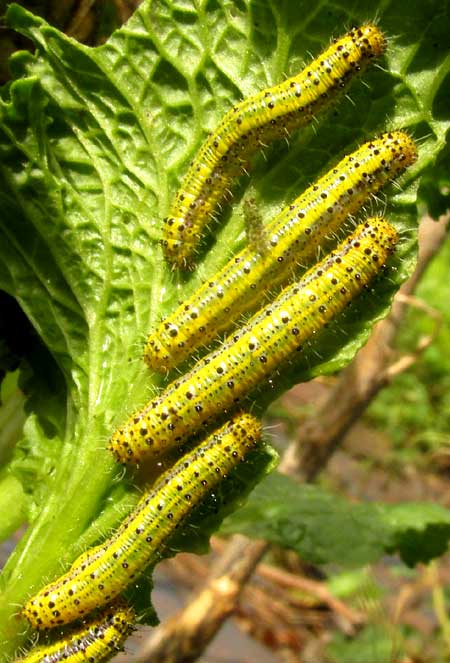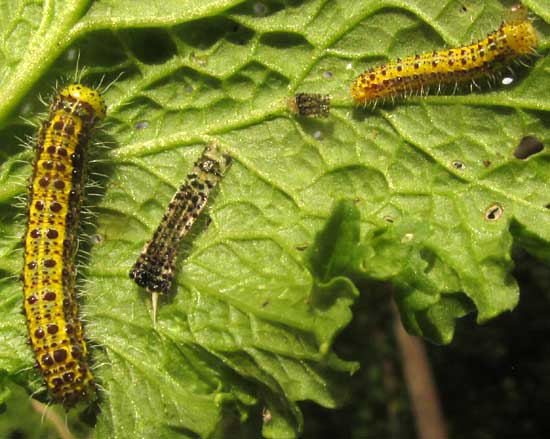Excerpts from Jim Conrad's
Naturalist Newsletter
from the July 20, 2018 Newsletter issued from Rancho Regenesis in the woods ±4kms west of Ek Balam Ruins; elevation ~40m (~130 ft), N~20.876°, W~88.170°; central Yucatán, MÉXICO
GREAT SOUTHERN WHITE CATERPILLARS
I've mentioned how here in the Yucatan, during the six months or so of the relatively cool dry season, I've never enjoyed such a fine crop of mustard greens. Up north, my mustard green beds normally are soon ravaged by insects. I've suggested that my success with mustard greens here is that the Mustard Family, the Brassicaceae, is a Temperate Zone family; members of the family are absent here in the Yucatan, except as occasional invasive weeds or planted, and sometimes people do plant cabbage here.
I've been eating mustard greens until now, well into the rainy season, but this week I pulled up all my plants. That's because suddenly the plants became heavily infested with caterpillars of what's commonly known as the Cabbage Butterfly, Cabbage White, and Large White.

*UPDATE: At first I thought these were the famous Pieris brassicae who feeds so voraciously on members of the Mustard Family. However, when the images were uploaded to iNaturalist, user "trinchan" recognized ASCIA MONUSTE, also a Mustard Family feeder, and found throughout much o the warmer parts of the Americas.
The caterpillars cluster side-by-side on the underside of a mustard-green leaf exactly as they're known to do. As they grow, Cabbage Butterfly caterpillars undergo four molts and five instars. The ones in the picture seem to be third or fourth instars. Below, you can see examples of two different instars:

In that picture the semitransparent, tubular items with black spots are "skins" shed as the caterpillars grew, passing from one instar to another.
Caterpillars of the Cabbage Butterfly feed on species of the Mustard Family, and I'm impressed that a female Cabbage Butterfly -- which I've never seen in the Yucatan -- managed to find a member of the Mustard Family in this isolated place. Mustard Family species contain "mustard-oil glucosides," which cause the caterpillars to taste bad to predators. It's supposed that this bad taste is why Cabbage Butterfly caterpillars are so brightly colored, instead of camouflaged: their showiness is a warning to predators. Often dangerous or bad-tasting organisms are brightly colored, and it's said that such colorful, unpalatable species are "aposematic."
The Cabbage Butterfly itself emits an unpleasant smell that deters predators, the odor deriving from the toxic mustard oil glycosides from food plants stored in the individuals' bodies.
So, this an interesting sighting. However, I'd rather do without the Cabbage Butterfly caterpillars in my wonderful mustard greens, than keep seeing the larvae eating my greens as I did this week.